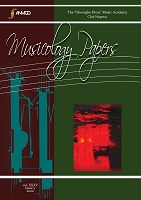Polystylistic Inflections in Diferencias by Cornel Țăranu
Polystylistic Inflections in Diferencias by Cornel Țăranu
Author(s): Mirela Mercean-ȚârcContributor(s): Marcella Magda (Translator)
Subject(s): Cultural history, Music
Published by: MediaMusica
Keywords: Polystylism; Cornel Țăranu; Diferencias; Tiento; Daniel Kientzy; saxophone concerto;
Summary/Abstract: This paper aims to highlight some of the functions and symbolic meanings of quotations in 20th-century post-avant-garde music in general, and in Cornel Țăranu’s Diferencias in particular. The New Historicity was identified and assimilated in music through trends such as the New Simplicity, the New Consonance and Polystylism, which were weaving their way among the various postmodern isms. At the same time, several composers used the stylistic copy, the quotation, or the collage as ways of relating to the historical past, to the ”great music”, viewed through the distorting magnifying glass of irony, parody, satire, as a first attitude (of breaking the routine of the public’s mental mechanisms), or as homage, as a second attitude. Diferencias for solo saxophone and orchestra by Cornel Țăranu, composed in 2010, is a Remembering Cabezon (1500-1566) homage work in which the composer quotes two different genres from his great forerunner’s oeuvre: Tiento for organ and Diferencias sobre un canto llano del Caualliero. The immersion in the historical time is produced either through a cinematic flash-type glissando, as Tiento 1 is introduced in the development of the work, a free sonata form with variations (diferencias), or through a transition provided by the glockenspiel and celesta, anticipating the “Variations on a Knight’s Smooth Song”. The solo commentary of the saxophone and orchestra that overlaps with the historical quotations constitutes those polystylistic inflections that characterize the semantics of the contemporary musical discourse, endowing it with symbolic values and correspondences. This paper analyses the relationship between temporality and structure-spatiality, highlighting some of the ways in which the composer understands the meeting between the two incompatible and seeminglyirreconcilable sound worlds, in a “concerto”-like ”confrontation” in which the beauty of ancient music and the virtuosity of contemporary writing come to terms in the realm of compositional mastery
Journal: Lucrări de Muzicologie
- Issue Year: 35/2020
- Issue No: 2
- Page Range: 24-33
- Page Count: 10
- Language: English
- Content File-PDF

